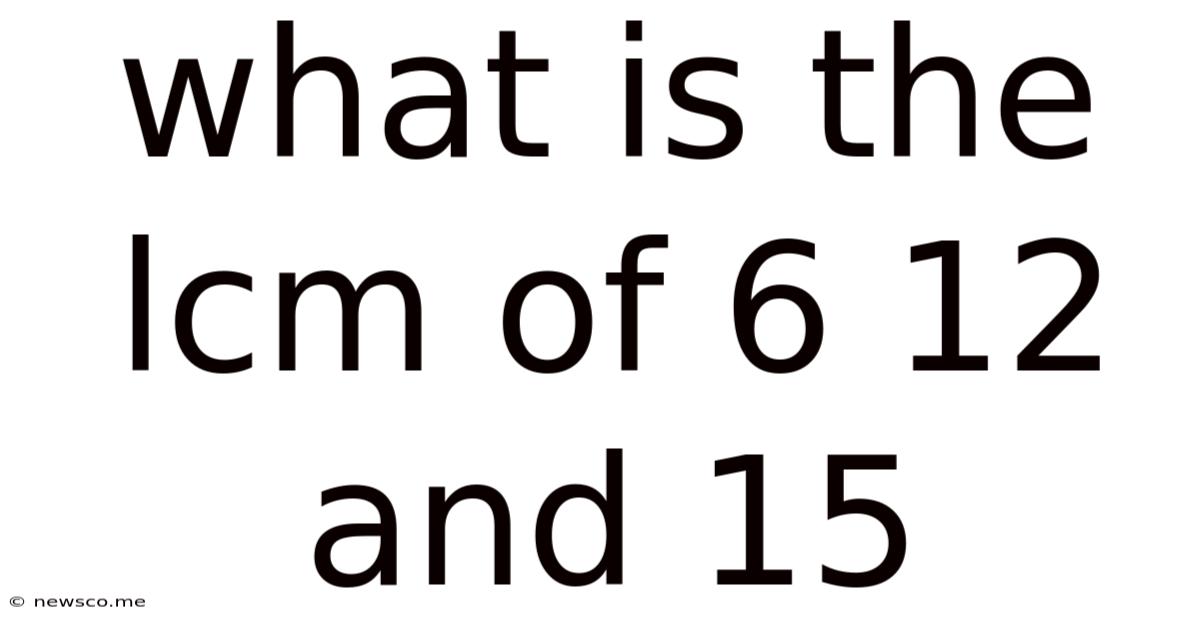What Is The Lcm Of 6 12 And 15
News Co
Apr 21, 2025 · 4 min read

Table of Contents
What is the LCM of 6, 12, and 15? A Deep Dive into Least Common Multiples
Finding the least common multiple (LCM) of a set of numbers is a fundamental concept in mathematics, crucial for various applications ranging from simple fraction addition to complex scheduling problems. This article will explore the concept of LCM, focusing specifically on how to calculate the LCM of 6, 12, and 15. We’ll delve into multiple methods, providing a comprehensive understanding of this mathematical operation and its practical implications.
Understanding Least Common Multiples (LCM)
The least common multiple (LCM) of two or more integers is the smallest positive integer that is divisible by all the integers. In simpler terms, it's the smallest number that all the given numbers can divide into evenly without leaving a remainder. This concept is vital in simplifying fractions, solving problems involving ratios and proportions, and even in more advanced mathematical fields.
The Importance of LCM
The LCM isn't just a theoretical concept; it has significant real-world applications:
-
Fraction Addition and Subtraction: Before adding or subtracting fractions, you need to find the LCM of the denominators to create a common denominator. This allows for straightforward addition or subtraction of the numerators.
-
Scheduling Problems: Imagine you have three events that occur at different intervals. The LCM helps determine when all three events will coincide. For example, if Event A happens every 6 days, Event B every 12 days, and Event C every 15 days, the LCM will tell you when all three will occur simultaneously.
-
Modular Arithmetic: LCM is fundamental in modular arithmetic, which is used in cryptography and computer science.
-
Music Theory: LCM is used to find the least common denominator when dealing with musical rhythms and time signatures.
Methods for Finding the LCM of 6, 12, and 15
Several effective methods exist to determine the LCM. Let's explore three common approaches:
1. Listing Multiples Method
This is a straightforward method, especially suitable for smaller numbers. We list the multiples of each number until we find the smallest multiple common to all three:
- Multiples of 6: 6, 12, 18, 24, 30, 36, 42, 48, 54, 60, ...
- Multiples of 12: 12, 24, 36, 48, 60, 72, ...
- Multiples of 15: 15, 30, 45, 60, 75, ...
By examining the lists, we observe that the smallest multiple common to 6, 12, and 15 is 60. Therefore, the LCM(6, 12, 15) = 60.
2. Prime Factorization Method
This method is more efficient for larger numbers. We first find the prime factorization of each number:
- 6 = 2 x 3
- 12 = 2² x 3
- 15 = 3 x 5
To find the LCM, we take the highest power of each prime factor present in the factorizations and multiply them together:
- Highest power of 2: 2² = 4
- Highest power of 3: 3¹ = 3
- Highest power of 5: 5¹ = 5
LCM(6, 12, 15) = 2² x 3 x 5 = 4 x 3 x 5 = 60
3. Greatest Common Divisor (GCD) Method
This method utilizes the relationship between the LCM and the greatest common divisor (GCD) of the numbers. The formula connecting LCM and GCD is:
LCM(a, b, c) = (|a x b x c|) / GCD(a, b, c)
First, we need to find the GCD of 6, 12, and 15. We can use the Euclidean algorithm for this:
- GCD(6, 12) = 6
- GCD(6, 15) = 3
Therefore, the GCD(6, 12, 15) = 3.
Now, we apply the formula:
LCM(6, 12, 15) = (6 x 12 x 15) / 3 = 1080 / 3 = 60
Choosing the Best Method
The best method depends on the numbers involved:
-
Listing Multiples: Suitable for small numbers where the LCM is relatively easy to spot.
-
Prime Factorization: Efficient for larger numbers as it systematically accounts for all prime factors.
-
GCD Method: Useful when you already know or easily find the GCD of the numbers. This method can be computationally more efficient for larger sets of numbers.
Real-World Application Examples
Let's illustrate the practical use of LCM with a couple of examples:
Example 1: Fraction Addition
Add the fractions: 1/6 + 1/12 + 1/15
- Find the LCM of 6, 12, and 15 (which we know is 60).
- Convert each fraction to have a denominator of 60:
- 1/6 = 10/60
- 1/12 = 5/60
- 1/15 = 4/60
- Add the numerators: 10/60 + 5/60 + 4/60 = 19/60
Example 2: Scheduling
Three machines operate on a cycle. Machine A completes a cycle every 6 hours, Machine B every 12 hours, and Machine C every 15 hours. When will all three machines complete a cycle simultaneously?
The LCM of 6, 12, and 15 is 60. Therefore, all three machines will complete a cycle simultaneously after 60 hours.
Conclusion
Finding the LCM of 6, 12, and 15, whether through listing multiples, prime factorization, or the GCD method, consistently yields the answer: 60. Understanding the LCM is critical for various mathematical applications and real-world problem-solving. Choosing the most appropriate method depends on the context and the numbers involved, ensuring efficiency and accuracy in your calculations. Mastering this fundamental concept lays the groundwork for success in more advanced mathematical studies and practical applications. Remember to practice these methods with different sets of numbers to solidify your understanding and build confidence in tackling more complex LCM problems.
Latest Posts
Related Post
Thank you for visiting our website which covers about What Is The Lcm Of 6 12 And 15 . We hope the information provided has been useful to you. Feel free to contact us if you have any questions or need further assistance. See you next time and don't miss to bookmark.